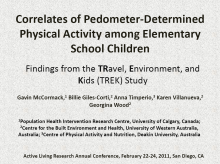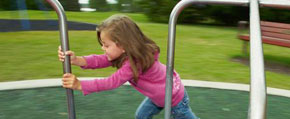We are pleased to announce an exciting new alliance between Active Living Research and GP RED to co-host and coordinate...
Correlates of Pedometer-Determined Physical Activity among Elementary School Children: Findings from the TRavel, Environment

Presentation at the 2011 Active Living Research Annual Conference
Background:
Regular physical activity can protect against weight gain among children, preventing the risk of adverse health outcomes including diabetes, hypertension, hyperlipidemia, asthma, adverse orthopedic conditions, and depression. Correlates of children’s physical activity are multilevel - including biological, psychological, behavioral, socio-cultural, and built environmental factors. Specifically, associations between self-reported and objectively-assessed built environmental attributes and children’s physical activity have been found, based mainly on self-reported behavior (which is prone to memory and recall bias). Pedometer-based recommendations for children and adolescents have recently been established (boys=15000 and girls=12000 steps/day) - primarily focusing on reducing obesity risk. Limited evidence regarding the correlates of achieving these recommendations exists.
Objectives:
To examine the associations between the built environment, social environment, independent mobility, travel to school, demographic characteristics, sedentary and leisure-time physical activity behavior, and: 1) pedometer-determined physical activity, and; 2) achievement of sex-specific BMI-referenced pedometer-determined cut-points, among elementary school-aged children.
Methods:
Public elementary schools (n=238) across metropolitan Perth (Western Australia) were assigned a child-specific walkability index (CWI) and socioeconomic (SES) score. The walkability index reflected the child-friendliness of the built environment for active travel within a 2km walkable service area, incorporating street connectivity and traffic exposure. Schools were divided into six strata based on combinations of the CWI (high vs. low walkable) and school area SES (low, medium, and high SES). Grade 5-7 children were randomly selected from the most (n=13) and least (n=12) ‘walkable’ schools, stratified by SES. Children (n=1480; RR=56.6%) and parents (n=1332; RR=88.8%) completed a survey, and children provided pedometer data (seven-day collection).
Surveys captured parent perceptions of the neighborhood environment (friendliness, traffic barriers; mix of destinations and presence of a relative’s and friend’s house within a 10-minute walk of home), independent mobility (child allowed to play or walk in the neighborhood unsupervised), social environment (friends in the neighborhood, dog ownership), sedentary behavior (screen-based activity), travel to school (frequency of being driven to school) and leisure-time activity (playing in the park, streets, or yard, playing team sport; clubs attendance; neighborhood walking; dog walking in last week), child’s sex and grade, parental highest education, marital status, the number of dependents <18 years, and home ownership. To capture potential peer influence on physical activity, average pedometer steps and the total number of students within the child’s grade within the school was estimated.
Using generalized linear modeling to adjust for school-level clustering, average daily pedometer-determined steps and achievement of recommended BMI-referenced pedometer-determined steps (binary outcome) were separately regressed onto the perceived neighborhood environment, independent mobility, social environment, travel to school, sedentary behavior, leisure-time activity, CWI, school area SES, and peer influence.
Results:
Complete survey and valid pedometer data (counts 1,000-30,000 steps/day for >=4 days) were obtained from 927 children. Average daily steps was significantly (p<0.05) higher among boys than girls (marginal mean (MM): boys=12052.88 vs. girls=10569.61 steps/day). Compared with grade 7, grade 5 students performed fewer steps (MM: 11,454.52 vs.11,220.75 steps/day, respectively). Children who spent =2 hours=10896.07 steps/day) and for each leisure-time activity reported steps increased 151.16/day. Children not driven to school performed more steps (MM: not driven =11517.66 vs. driven=11104.83 steps/day) and children not allowed to play or walk in their neighborhood unsupervised took fewer daily steps than others (MM: allowed=11475.91 vs. not allowed=11146.58 steps/day). As the average number of steps among students within the child’s grade increased the child’s own steps also increased (432.92 steps/day for each 500 step/day increase within the grade).
Compared with girls, boys were significantly (p<0.05) less likely to achieve recommended pedometer steps (OR=0.43). Recommended steps was more likely among children who participated in 10-minutes from their friend’s house were less likely to achieve recommended steps (OR=0.65) while attending a school located in a high SES neighborhood was positively associated with recommended steps (OR=1.33). Walkability of the school neighborhood was not associated with steps.
Conclusions:
Higher levels of physical activity among children may be possible if multi-level interventions, programs, and policies are devised aimed at encouraging use of active travel modes to and from school, reducing screen-based activity, addressing parental concerns and increasing children’s opportunities for more independent mobility, encouraging participation in organized and non-organized active leisure pursuits, fostering a classroom and school culture that encourages more physical activity at school, and targeting schools in disadvantaged areas.
Support:
NHMRC, VicHealth, CIHR
STAY UP TO DATE
RECENTLY ADDED TOOLS & RESOURCES
MOVE! A BLOG ABOUT ACTIVE LIVING
The "Active Living Conference" aims to break down research and practice silos and...







